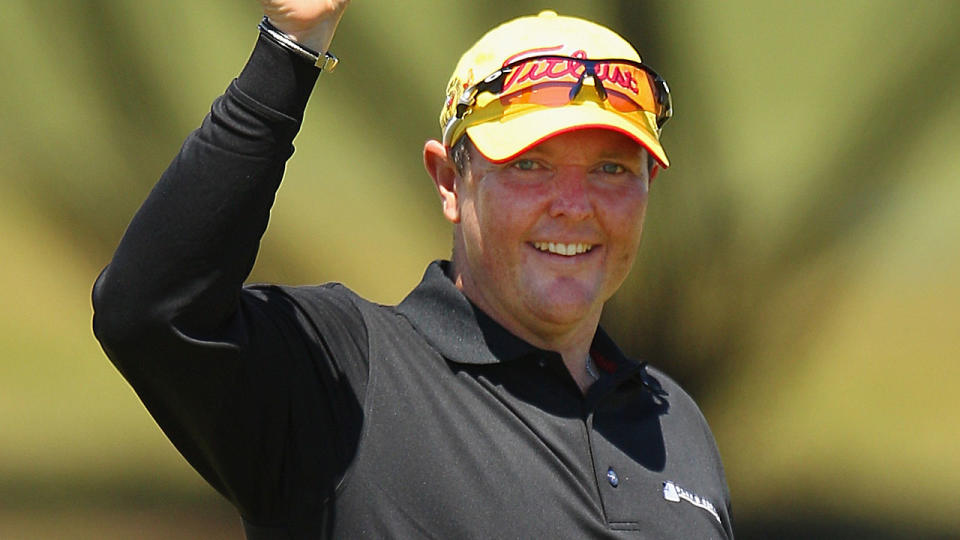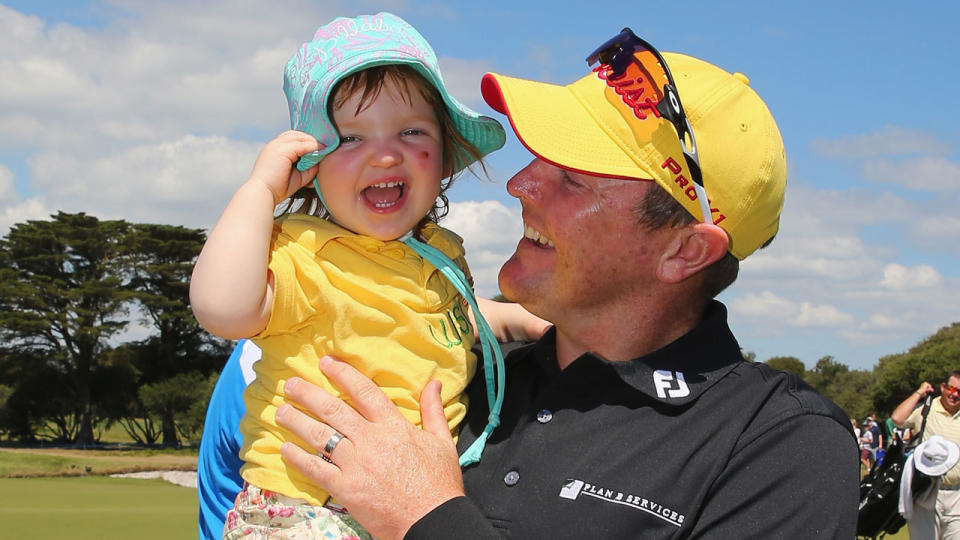Golf world pays tribute to 'inspirational' Jarrod Lyle
The golf world has paid tribute to Jarrod Lyle, who died aged 36 on Wednesday night surrounded by family at his home in Torquay after a long battle with cancer.
Lyle was first diagnosed with acute myeloid leukaemia in 1999 when he was 17 and a promising amateur golfer.
He spent much of the next nine months in Melbourne’s Royal Children’s Hospital fighting the disease and it was another year after that before he could walk around a golf course.
He turned professional in 2004, but in 2012, while at home in Victoria for his marriage to Briony and the birth of their first child Lusi, a relapse of the leukaemia was diagnosed.
He was declared to be in remission the following the year and made his comeback in the 2013 Australian Masters at Royal Melbourne.

Remarkably, Lyle again made his way back to the PGA Tour and played 20 more tournaments in 2015 and 2016 with moderate success.
He became one of the world’s most universally admired golfers, as shown by the response to the news last week that Lyle would cease active cancer treatment.
The world’s best pinned yellow ribbons to their hats at the WGC-Bridgestone Invitational last week, while it emerged overnight that Tiger Woods and Bryson DeChambeau planned to donate $35,000 to Lyle’s family.
As the Australian golfer’s family shared his beautiful final message, his colleagues shared their grief with touching notes of their own.
Such a sad day, we will all miss you so much Jarrod. Thinking of his family at this time. #RIPJarrod #BucketHat 💛💛💛 https://t.co/IeGeIbFk2b
— Justin Rose (@JustinRose99) August 8, 2018
Can’t send enough love and well wishes to the Lyle family at this time. Can only imagine what his family are going through. Inspirational man !!
— Tommy Fleetwood (@TommyFleetwood1) August 8, 2018
We lost a great one today. RIP, Jarrod. We will all be thinking about him and his family this week 🙌🏼 https://t.co/wJL6ZZNREi
— Justin Thomas (@JustinThomas34) August 9, 2018
We are very sad to hear of Jarrod Lyle’s passing. He fought a good fight and will be forever remembered for his courage, strength, perseverance and the light he brought to all of our lives. The world lost a good man. RIP Jarrod. – Ernie, Liezl, Samantha and Ben
— Ernie Els (@TheBig_Easy) August 8, 2018
Our thoughts and prayers go out to the Lyle family. You were and always will be a fighter and will be missed by so many people. Rest In Peace Jarrod.
— Patrick Reed (@PReedGolf) August 8, 2018
Even though we knew it was coming it’s still hard to write. RIP great man Jarrod Lyle 💛
— Aron Price (@aronpricePGA) August 8, 2018
A great man gone way to soon! Let’s celebrate the life of jarrod.lyle ! RIP my friend https://t.co/Ht5Tf9Y0xx
— Colt Knost (@ColtKnost) August 8, 2018
It is through a river of tears I say goodbye to my friend Jarrod Lyle. A wonderful father, friend and golfer. Quick with a joke, didn’t mind a beer, and just a pure joy to be around every day. Miss you mate. RIP
— Greg Chalmers (@GregChalmersPGA) August 8, 2018
One of greatest nicest Australian golfer I’ve ever met… and their family has gone through a lot. One of best family I’ve ever seen. Let’s help this great hearted family for jarrod everyone! https://t.co/HynfAR5giH
— Danny Lee (@dannygolf72) August 8, 2018
Tough to know that we just lost a great person in this world! RIP Jarrod Lyle! You will be greatly missed my friend! ❤️
— Billy Horschel (@BillyHo_Golf) August 8, 2018
Thoughts and prayers with @jarrodlylepga and his family. A great father and true warrior who fought so courageously against cancer.
— Ryan Blaum (@RBlaumGolf) August 8, 2018
So sad to hear of the passing of our friend @jarrodlylepga. Your family are in my thoughts and prayers Pal. Your legacy of toughness and kindness will live on. #effcancer pic.twitter.com/le64IGtV44
— Tony Finau Golf (@tonyfinaugolf) August 8, 2018
It is with a heavy heart and a mountain of tears that I say a final goodbye to my friend Jarrod Lyle. For 20 years he fought this disease like no one could. Thank you for touching us all in so many wonderful ways! RIP to a champion of a human.
— Tripp Isenhour (@TrippIsenhourGC) August 8, 2018
Sad day to hear the awful news on Jarrods passing 😢 He was and will always be a likeable,funny and fun guy. Feel very lucky to have known and played golf in his company. Thoughts and prayers are with all the Lyle family. #youllbemissedJL #neverforgotten #RIP
— Ross Fisher (@RossFisher) August 8, 2018
We are truly heartbroken today as we say goodbye to our friend Jarrod Lyle. Jarrod showed amazing courage and grace throughout his battle, and we will miss him dearly. We send our deepest sympathies to the entire Lyle family. pic.twitter.com/90bP8iyQTN
— Titleist (@Titleist) August 8, 2018
The story of Jarrod Lyle’s life and battles
Over the past 15-or-so summers, just about the best news any golf fan in Australia could hear was that Jarrod Lyle would be playing in the Masters or the Open, or anywhere at all.
Forget about Tiger Woods and the rest. If Lyle was playing it was a bonus, a special joy just to know the big, smiling guy from Shepparton was well enough to tee it up.
It didn’t always happen, and won’t again.
But an enormous legacy of inspiration remains for a man who repeatedly battled life-threatening illness with courage, grace and trademark generosity of spirit.
When he was finally fit enough to play competitively after his first fight as a teenager, Lyle reduced his handicap to scratch by the time he turned 19 and a couple of years later won a Victorian Institute of Sport golf scholarship.
For the next few years it was as though he was making up for lost time. He turned professional in 2004, qualified for the Asian Tour within another year, and less than 12 months after that was playing in the US on the second-tier Web.com Tour.

In his first season he finished 18th in the money list, earning himself a ticket to play on the US PGA Tour for 2007.
The vagaries of golf came into play and Lyle finished his first season on the world’s most lucrative golf circuit in 164th place on the money list and had to drop back a level to what had been renamed as the Nationwide Tour.
With experience by then to match his natural ability, Lyle won two Nationwide events in 2008, finishing fourth on the money list and again being elevated to the US PGA Tour.
In 2011 he lost his tour card again but earned it back at qualifying school then achieved his best PGA Tour result of tied fourth in Los Angeles early in 2012.
Returning to live in Australia after 2016, he and Briony had their second daughter, Jemma.
Then, in 2017, while being treated for a cough, it was discovered that the leukaemia had returned.
Lyle and Briony launched a line of golf apparel and as his recovery progressed he joined the TV commentary team for the Australian Open.

At the same time, doctors presented Lyle with new realities, the gravity of which he revealed in an online blog.
“Things are about to get really serious for me and my health over the next couple of months,” he wrote.
“Next week I’m going to hospital for a bone marrow transplant. I’m shitting myself.”
Lyle explained that he would receive stem cells in a bone marrow transplant from his brother Leighton.
“At best I’ve got a one-in-four chance of coming out the other side,” he wrote.
“That’s why I’m so scared.”
With typical courage, Lyle fought on, and as his situation became known, the entire golf world rallied.
The first month of 2018 was declared “January for Jarrod” month on the US PGA Tour and tributes began to appear on the social media accounts of every prominent player in the world.
Meanwhile, as Lyle grew weaker, Briony took over writing the blog. In June she revealed the extent of the debilitating effects of not just the cancer, but associated auto-immune disorders that affected his eyesight and hearing and robbed him of all strength.
“His goals have been reduced to the smallest things, like being able to spread jam on his toast,” Briony wrote.
As serious as the situation had become, there seemed to be hope.
“We are certain we will get through this crap once again, but it’s really hard to stay upbeat,” she wrote in June.
And in late July: “… things continue to be incredibly tough.”
A week later, Lyle and his doctors decided medical treatment should cease and he receive only palliative care.
“He has given everything that he’s got to give, and his poor body cannot take any more,” Briony wrote.
Messages of support flowed from tour peers and others touched by his story around the globe.
Tiger Woods was among those wearing a Leuk the Duck badge in his cap in recognition of Lyle and Challenge, the children’s cancer foundation he was an ambassador for.
Lyle won two professional tournaments in a career that was never able to flourish, but he will be remembered for much more than golf.
with AAP